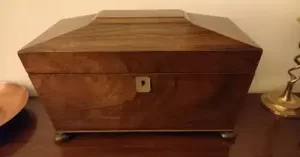Your basket is currently empty!
Tea Chests
18th Century Tea Chests: for a valuable new commodity
 Tea first exported from China to England in was extremely expensive and was stored in ceramic Chinese caddies, frequently blue and white. Soon tea chests were made in which to keep these tea caddies under lock and key and to be placed in the drawing room. The styles of these tea boxes had therefore to fit in with the decor and furniture there.
Tea first exported from China to England in was extremely expensive and was stored in ceramic Chinese caddies, frequently blue and white. Soon tea chests were made in which to keep these tea caddies under lock and key and to be placed in the drawing room. The styles of these tea boxes had therefore to fit in with the decor and furniture there.
The accompanying photograph is of a late 18th century chest passed down my family. The fashionable sarcophagus shaped chest contains two zinc lined storage boxes for black tea and green tea. Earlier chests contained round silver tea caddies. In the centre of the chest was a larger, round canister which contained crushed sugar royal.
This chest is rosewood but mahogany was also popular. It features a lock to guard against pilfering servants. Early canisters were bottle shaped, originally of a Chinese design and would have typically been ceramic or glass.
There is a large variation in the style and format of chests from the Georgian through to the Victorian periods. The earliest date from the 1720s.
Initially the designs for tea chests were modelled upon those of Chinese origin but British manufacturers soon began to create designs of their own. The popular sarcophagus designs were based upon considerably larger French empire-style wine coolers. Tea chests were often inlaid with mother of pearl, brass, ivory or ebony. Fittings could be brass or turned wood.
Tea chests fell out of use as the price of tea fell and consumption increased. Tea caddies were then moved to the kitchen.
See tea caddies in our tea store.
